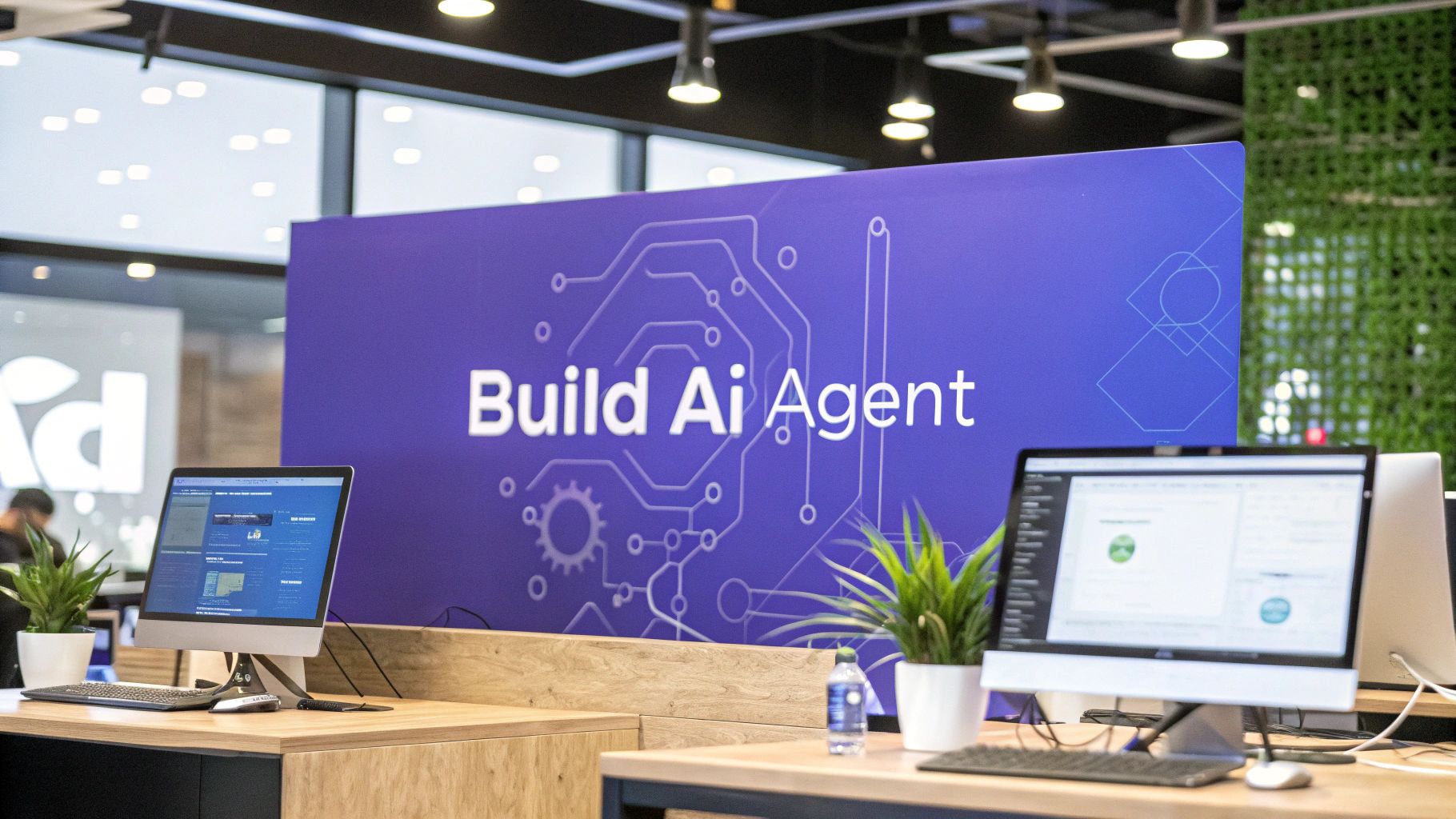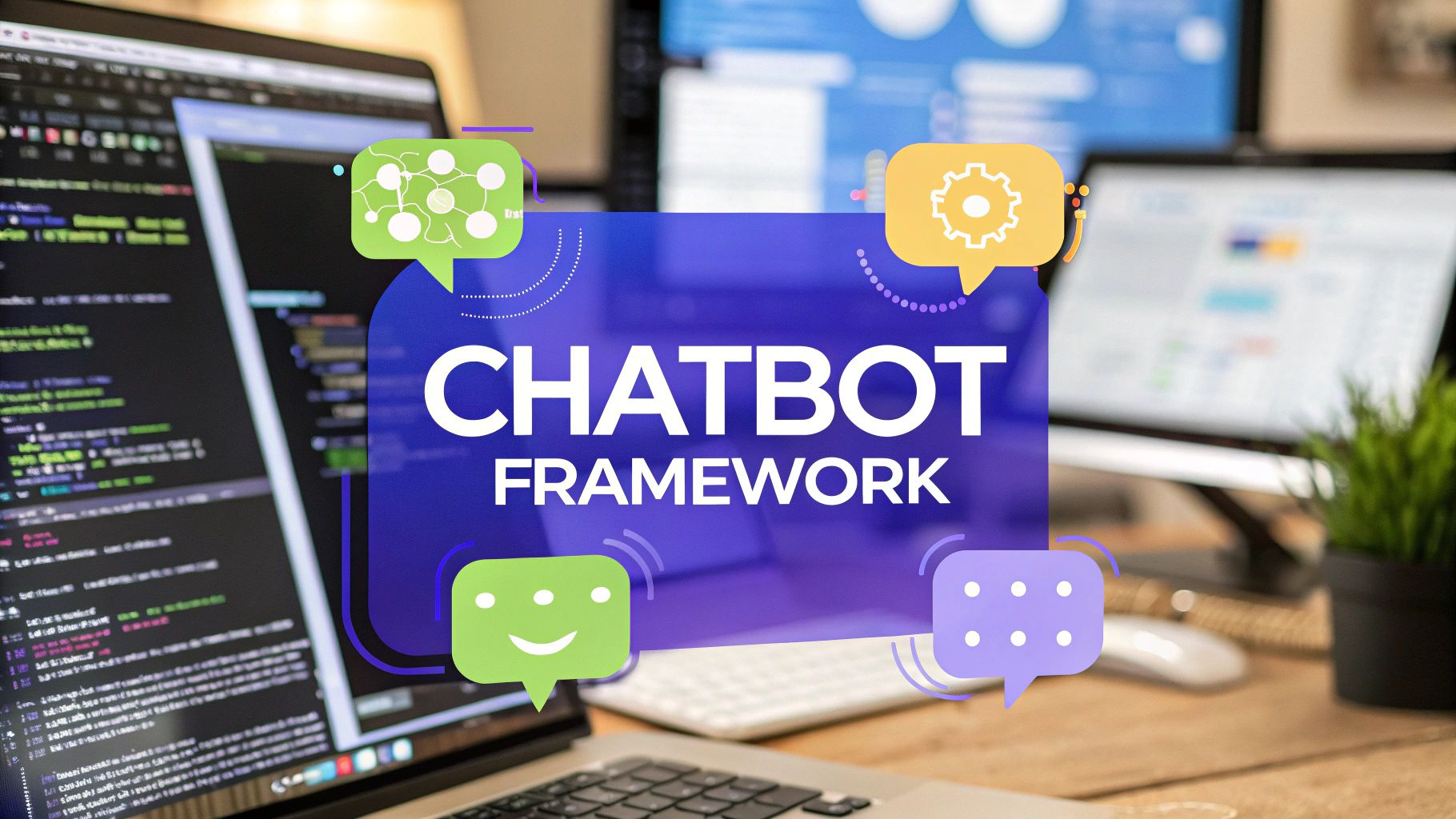How to Build a Chatbot That People Actually Use
Learn how to build a chatbot with our guide to planning, building, and optimizing. Go from concept to a fully functional AI chatbot without writing code.
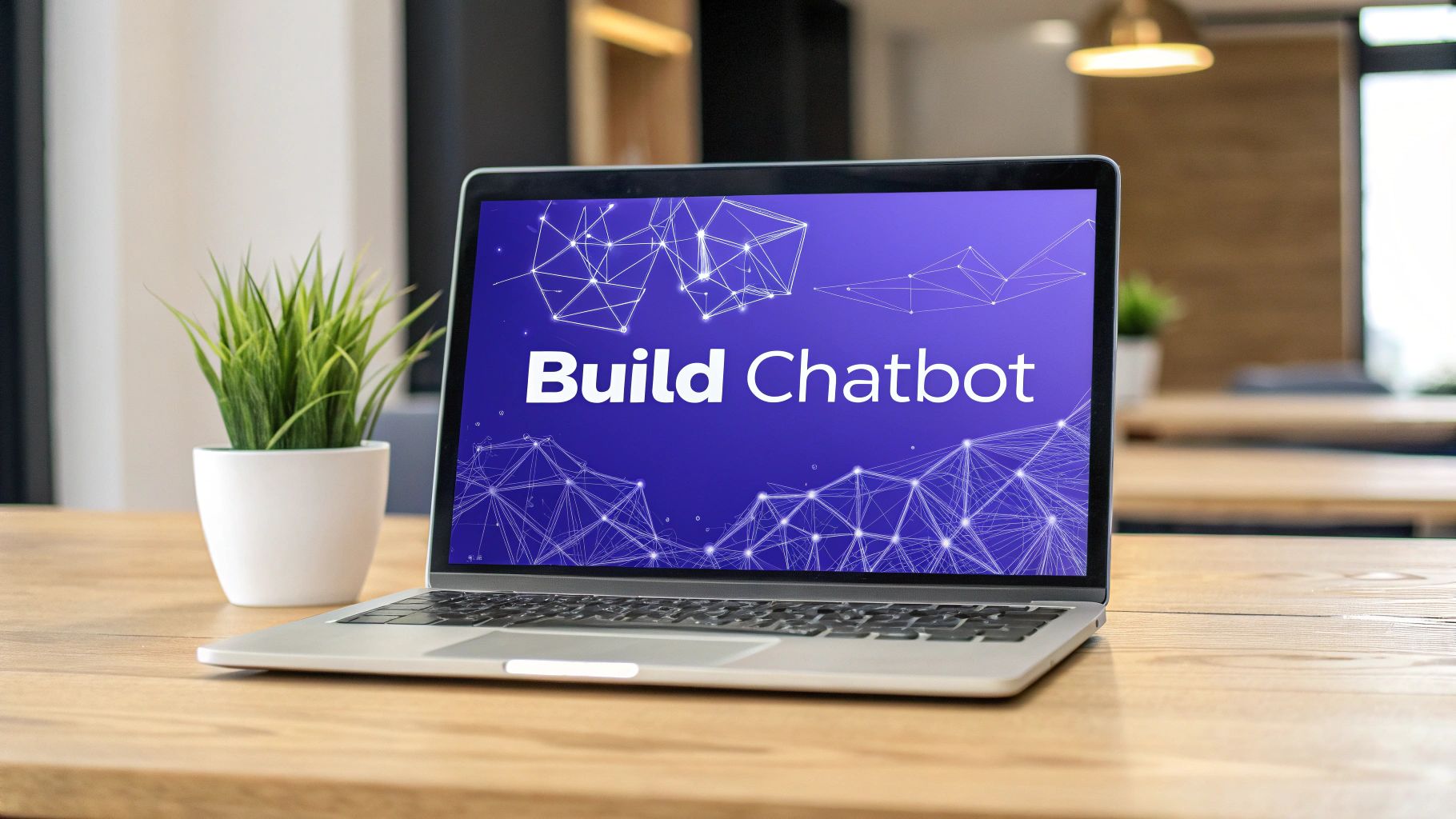
Gone are the days when learning how to build a chatbot was a project reserved for developers. With today's platforms, you can spin up a custom AI assistant in a few hours, train it on your own business data, and have it live on your website before the day is over. It's a game-changer that makes powerful AI genuinely accessible.
Why Your Business Needs a Chatbot Right Now
Let's cut through the hype. Chatbots aren't just a tech novelty anymore; they’ve become a fundamental tool for any modern business. Their real value comes from solving practical problems: handling customer questions at scale, freeing up your team for more complex issues, and delivering the instant, 24/7 support that customers now expect.
The biggest win is a massive boost in operational efficiency. Instead of hiring more people to answer the same questions over and over—like "Where is my order?" or "What are your hours?"—a chatbot can field thousands of those queries at once. It never gets tired or makes a mistake. This translates directly into cost savings and lets your team focus on work that actually drives revenue.
The Undeniable Market Momentum
The numbers don't lie. The global chatbot market was valued at around $2.47 billion in 2021. By 2025, it exploded to $15.57 billion and is on track to hit a staggering $46.64 billion by 2029.
This growth isn't just a bubble. It’s fueled by businesses realizing they can save up to $11 billion and more than 2.5 billion work hours every single year. This isn't just a passing trend; it's a strategic shift. To really grasp the impact, it’s worth digging into how AI empowers customer support and reshapes service operations from the ground up.
More Than Just Answering Questions
A well-designed chatbot does a lot more than just spit out pre-written answers. It becomes an active part of your customer journey and even your internal workflows.
- Lead Generation: It can engage visitors, ask qualifying questions, and even book demos right on your sales team's calendar.
- Customer Onboarding: A bot can walk new users through your product, answer their first few questions, and make sure they get started on the right foot.
- Internal Support: You can deploy it on Slack or Google Chat to act as an instant HR or IT helpdesk, answering common questions about company policies or tech issues.
For example, a platform like Chatiant is built for this kind of deep integration.
The interface shows just how simple it is to train an AI on your specific data, ensuring it gives relevant, on-brand answers whether it's talking to a customer or helping a team member internally.
The real power of a modern chatbot lies in its ability to be trained on your specific content. By simply providing a link to your website or uploading documents, you create a specialized expert on your business, not a generic answering machine.
Learning how to build a chatbot is an investment in future-proofing your business. It lets you scale customer interactions, improve efficiency, and deliver the kind of instant, helpful experiences that build real loyalty.
Choosing Your No-Code Chatbot Platform
With so many tools out there, picking the right one can feel overwhelming. The key is to find a platform that balances power with simplicity and offers the specific features you need, like website data training and easy integration.
Here’s a quick comparison to help you see how Chatiant stacks up against other popular no-code solutions.
While other platforms are great for specific tasks like lead capture forms or basic FAQs, Chatiant is designed for businesses that need a true AI expert trained on their own knowledge base. This flexibility makes it ideal for both customer-facing and internal support scenarios.
Crafting Your Chatbot Blueprint Before You Build
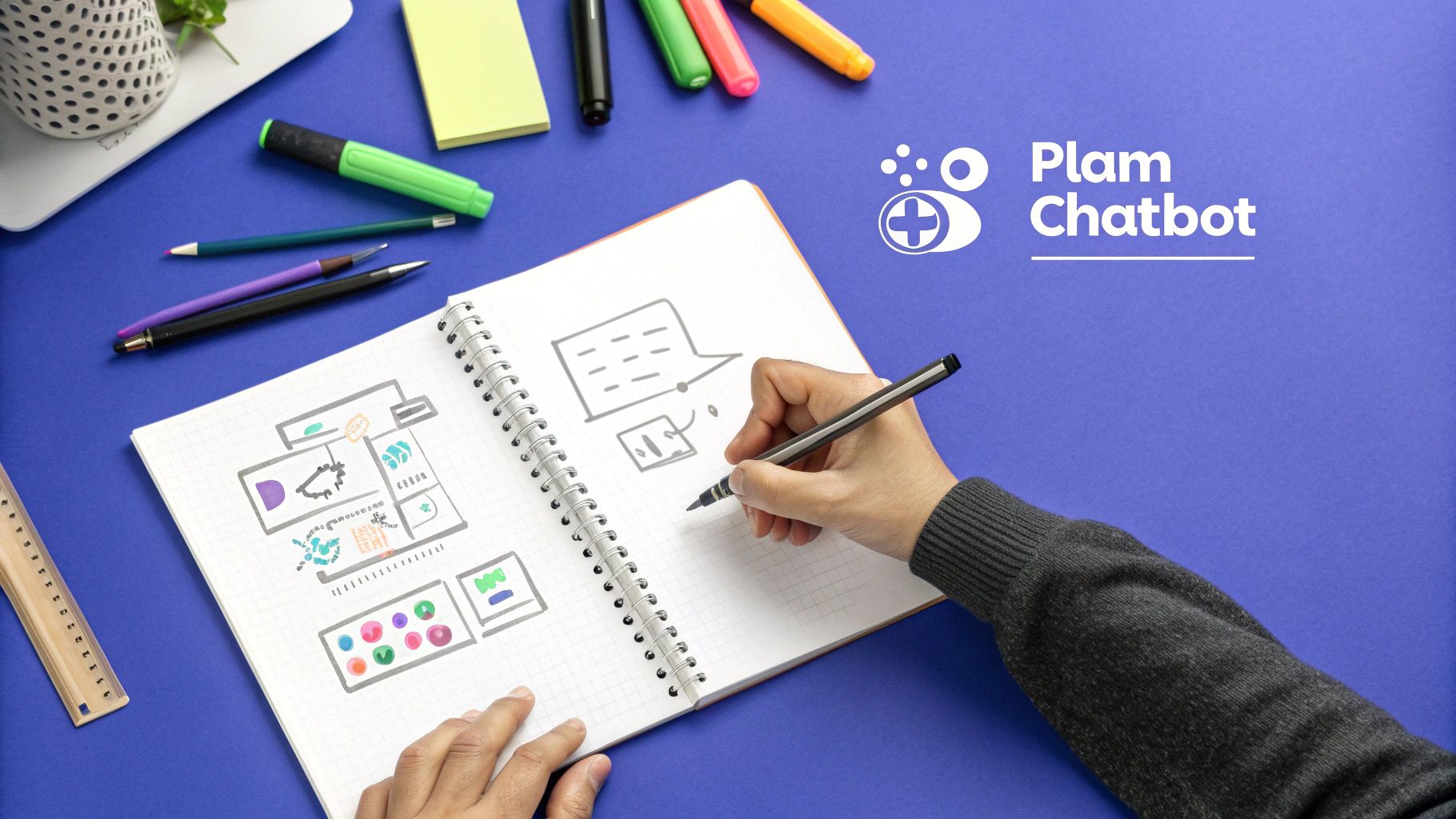
It’s tempting to jump right into a chatbot builder and start clicking around. But building a bot without a plan is like trying to build a house without a blueprint. You might end up with something that stands, but it won’t be functional, welcoming, or useful to anyone who stops by.
This initial planning phase is easily the most important step. It’s what separates a chatbot that genuinely helps people from one that just adds to their frustration.
Define Your Chatbot’s Core Mission
Before you write a single line of dialogue or upload any data, you have to decide on your chatbot's primary job. A bot that tries to do everything will inevitably fail at all of it. Is it a 24/7 support agent? A lead-gen machine? An onboarding guide for new customers? Each goal demands a completely different strategy.
Clarity here simplifies every decision that follows. A focused chatbot is an effective one.
- For Customer Support: The main goal is resolution speed. The bot needs to understand problems quickly and pull accurate answers from your knowledge base or FAQs. Its personality should be patient, clear, and empathetic.
- For Lead Generation: The focus shifts to qualification and conversion. The bot has to ask the right questions to identify good leads, grab their contact info, and maybe even book a demo. Its tone should be engaging, persuasive, and helpful.
- For User Onboarding: The objective is guidance and education. It should proactively walk new users through key features, answer common "how-to" questions, and drive product adoption. Here, the personality needs to be encouraging and knowledgeable.
Trying to cram all three into one bot from the get-go creates a confusing mess for the user. Nail one mission first, and you can always expand its skills later on.
Map Potential User Conversations
Once you know the mission, it’s time to get inside your user’s head. What are they actually going to ask? Don't just guess. Dig into your existing support tickets, live chat transcripts, and sales team emails. Find the top 10-20 questions that pop up over and over again.
This research forms the foundation of your chatbot's knowledge. For an e-commerce site, these are likely questions like:
- "What is your return policy?"
- "Where is my order?"
- "Do you ship to Canada?"
For a SaaS company, you'll probably see things like:
- "How do I reset my password?"
- "Does this integrate with Salesforce?"
- "Can I get a demo?"
Mapping these out helps you anticipate what users need and makes sure your bot is ready with the right answers from day one. This simple step prevents the dreaded "I don't understand" response that sends users running.
Building a chatbot isn't just a technical task; it's an exercise in empathy. You have to understand your user's intent, predict their frustrations, and design conversations that guide them to a solution with minimal effort.
Give Your Chatbot a Personality
Finally, your chatbot shouldn't sound like a robot. It’s an extension of your brand, and its personality should reflect that. A fun and informal brand can get away with a bot that uses emojis and a bit of humor. A more corporate, serious brand needs a bot that’s professional, direct, and formal.
Think about these elements to define your bot's voice and tone:
This personality needs to be consistent in every interaction, from the first "hello" to how it handles an error. This is the detail that makes a chatbot feel like a helpful assistant instead of a clunky piece of software. It’s a small thing that makes a huge difference in user engagement.
Building Your First AI Chatbot With a No-Code Platform
With your blueprint in hand, it’s time to move from planning to the fun part: building. This is where all that strategic work you've done starts to pay off. We’re about to walk through the click-by-click process of creating your first AI assistant, and you won’t need to write a single line of code.
Platforms like Chatiant are built to make this process feel intuitive. You don’t need to be a developer to create something powerful. The main idea is to give the AI a "brain" by hooking it up to your existing business information. This ensures it provides accurate, context-aware answers that actually sound like your brand.
Connect Your Data Sources
First things first: you have to train your chatbot. An AI chatbot is only as smart as the data you feed it. This knowledge base is what it uses to understand questions and piece together helpful replies. Luckily, modern platforms give you a few straightforward ways to do this.
The most common and effective method is to simply connect your website. You provide your site's URL, and the platform’s crawlers will read through everything—your blog, FAQ pages, product descriptions, and support articles—to build its understanding. It's incredibly efficient because your website is usually the most complete, up-to-date source of your public information.
You can also upload documents directly. This is perfect for internal information that isn’t public-facing, such as:
- Detailed product manuals or technical specs
- Internal support knowledge bases or HR policy docs
- Sales scripts or battle cards
For example, a software company might upload its entire technical documentation library in PDF format. This lets the chatbot answer highly specific questions from developers or power users—something a bot trained only on marketing pages could never handle.
Customize Your Chatbot’s Look and Feel
Your chatbot is part of your website's experience, so it should look like it belongs there. A generic, unbranded widget can feel jarring and make visitors feel like they can't trust it. Most no-code platforms offer solid customization options to keep everything consistent with your brand.
You can typically adjust:
- Colors: Match the widget’s header, background, and buttons to your brand’s palette.
- Logo: Pop your company logo right into the chat header.
- Avatar: Give your bot a friendly face, whether it’s an illustration or a simple icon.
This isn’t just about making it look pretty; it's about building trust. When a chatbot is visually integrated, it feels like a native part of your brand, not some clunky third-party add-on.
Here’s a peek at the Chatiant dashboard, where these settings are super easy to find and change.
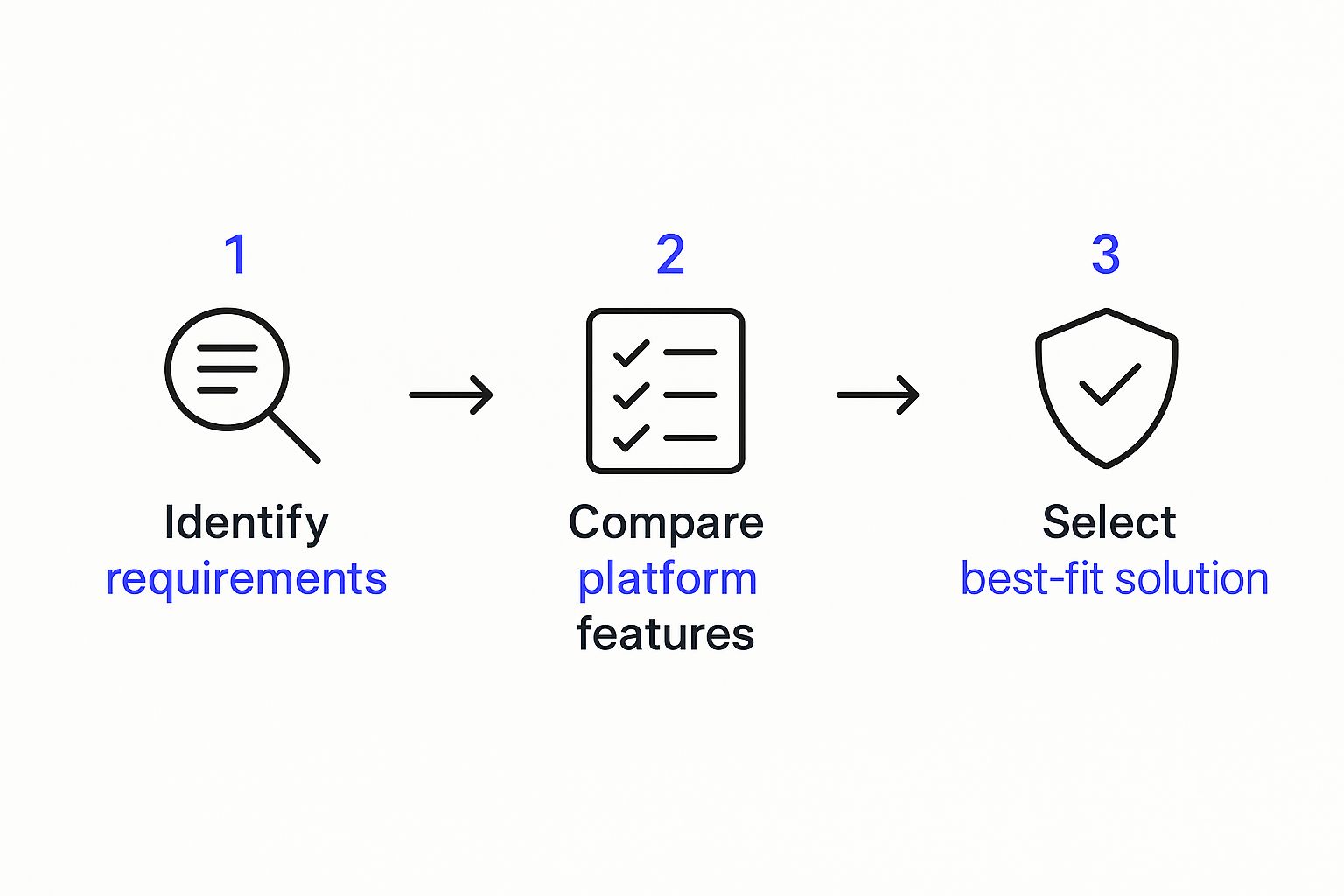
As you can see, the interface is designed to let you quickly customize the bot's appearance and behavior without ever touching code.
Configure Core Behaviors and Welcome Messages
How your chatbot greets a visitor can be the difference between them engaging or instantly closing the window. A great welcome message is an invitation to a conversation. Instead of a passive "How can I help you?", try something more proactive and specific to the page they're on.
For a pricing page, you could try something like:
"Hi there! Have questions about our plans or which one is right for you? I can help compare features."
Or, on a blog post about a specific topic:
"Enjoying the article? Ask me anything else about this topic, and I'll find the answer for you!"
These contextual greetings show the user the bot is smart and actually relevant to what they're doing. Beyond the welcome, you can configure other behaviors, like setting up suggested questions ("What is your pricing?" or "How do I get started?") to give users easy conversation starters. For more ideas, check out our guide on how to add a chatbot to your website.
This initial setup is more than just a trend. The chatbot market is exploding, projected to climb from $9.56 billion in 2025 to a massive $27.29 billion by 2030. This growth is driven by huge leaps in Natural Language Processing (NLP), which helps bots understand what users actually mean—a must-have for industries like e-commerce and banking that need to provide instant, 24/7 service.
By focusing on these three areas—connecting your data, customizing the look, and configuring behavior—you can launch a genuinely helpful and on-brand AI chatbot. No-code platforms take what used to be a technical headache and turn it into a strategic tool that anyone on your team can build and manage.
Getting Your Chatbot Live and In Front of Customers

You’ve done the hard work of planning and training. Now you have a smart, well-trained AI assistant ready to go. But a brilliant chatbot is useless if it’s just sitting in the workshop. This next part is all about getting your bot out into the world where your customers can actually talk to it.
Deployment is more than just flipping a switch. It’s a strategic process of embedding the bot on your website, connecting it to other platforms your customers use, and launching it in a way that guarantees a smooth, positive first impression.
Let’s get tactical.
Simple Website Embedding
The most common and impactful place to put your chatbot is directly on your website. For most no-code platforms like Chatiant, this is a refreshingly simple process that doesn't require any deep technical skills.
Usually, the platform gives you a small piece of JavaScript code. All you need to do is copy this snippet and paste it into your website's HTML, typically right before the closing </body> tag. Once you do that and republish your site, the chatbot widget will pop up, ready to engage visitors.
This copy-paste approach works with just about any website builder or CMS you can think of, including:
It’s a five-minute job that instantly makes your bot accessible to every person who lands on your site.
Launching with a Smart Strategy
While it’s tempting to go live for everyone at once, a phased rollout is a much smarter move. This lets you catch any unexpected issues in a controlled environment before exposing your chatbot to your entire audience. A strategic launch minimizes risk and maximizes your chances of success.
First, always test on a staging site. A staging or development version of your website is the perfect sandbox. Here, you and your team can interact with the bot just as a real user would—checking for conversational glitches, incorrect answers, or branding inconsistencies—without any public visibility.
A "soft launch" is your secret weapon. Before the grand reveal, invite a small, trusted group of power users or friendly customers to try out the chatbot. Their real-world feedback is invaluable for finding gaps in its knowledge and refining its personality.
This methodical approach ensures that by the time you launch fully, your bot is polished, helpful, and ready to make a great first impression on every single visitor.
Before you go live, a simple checklist can save you from common launch-day headaches. It helps ensure all the small but critical details are covered.
Your Pre-Launch Deployment Checklist
Here’s a practical checklist to run through to ensure your chatbot launch goes off without a hitch.
Running through these steps helps you launch with confidence, knowing you’ve covered your bases.
Going Beyond Your Website
Why limit your chatbot to just your website? To deliver truly seamless support, you need to meet your customers where they already are. Integrating your chatbot with popular messaging apps extends its reach and makes it even more convenient for users to get help.
Many businesses are discovering the power of deploying their AI on platforms like:
- Slack: Perfect for providing instant internal support to your team for HR, IT, or operations questions.
- Google Chat: Another excellent option for internal-facing bots that can answer questions and automate tasks within your company's workspace.
- WhatsApp & Messenger: Ideal for B2C companies, allowing customers to get order updates, ask questions, and receive support right from their favorite messaging app.
When planning for a global audience, this multi-platform approach becomes even more critical. For instance, the Asia-Pacific region drove about 85% of global chatbot retail spending in 2023, largely through apps like WhatsApp and WeChat. However, forecasts show that by 2028, 66% of chatbot investment will come from outside this region, underscoring the need for scalable, multi-language bots. You can find more details about these chatbot market trends.
Measuring and Improving Chatbot Performance

Your chatbot's launch day isn't the finish line; it’s the starting block. A truly successful chatbot is one that evolves. It gets smarter, more helpful, and more efficient over time, but that improvement doesn't happen by magic. It comes from systematically listening to your users and treating their interactions as a roadmap for what to fix next.
This is where you go from just building a chatbot to becoming a chatbot "whisperer." You learn to interpret the subtle clues in conversation logs, spot patterns of frustration, and identify the gaps in your bot's knowledge. These insights are gold, turning your AI assistant from a good tool into an indispensable part of your business.
Digging into Conversation Logs
The most direct way to see how your chatbot is really doing is to read the conversations it's having. This isn't about micromanaging every single interaction. It's about spotting high-level trends and finding opportunities for quick wins.
When you’re reviewing logs, you’re looking for a few key things:
- Unanswered Questions: What are users asking that the bot can't handle? A high frequency of "I don't understand" or similar fallback messages is a clear signal that a specific topic is missing from its knowledge base.
- User Frustration: Look for short, repetitive questions, users rephrasing the same thing multiple times, or conversations that are quickly abandoned. These are signs the bot isn't grasping what the user actually wants.
- Common Successful Queries: Don't just focus on the negative. Make a note of the questions your bot nails. This helps you understand what's working and validates the quality of your existing training data.
For example, you might notice ten different users asking, "Do you offer discounts for non-profits?" If your bot fails to answer, you've just found a critical piece of content to add. This simple act of reviewing and retraining is fundamental to building a chatbot that people actually trust.
Key Metrics That Actually Matter
While reading logs gives you qualitative insights, you also need hard numbers to track progress and prove value. It's easy to get lost in "vanity metrics" like the total number of conversations. Instead, focus on KPIs that measure effectiveness and user satisfaction.
A crucial first step is setting up Google Analytics conversion tracking. This helps you connect chatbot interactions to tangible business outcomes, like leads generated or support tickets deflected.
The goal isn't just to have a busy chatbot; it's to have an effective one. Success is measured by how many problems it solves and how happy it makes your users, not just by how many messages it sends.
Here are the most important metrics to keep an eye on:
For a deeper dive into these KPIs, check out our guide on the essential analytics for chatbots to build a robust reporting dashboard.
The Continuous Improvement Loop
Measuring performance is only half the battle. The other half is acting on what you've learned. This creates a powerful feedback loop that drives continuous improvement, turning a good chatbot into a great one.
Here’s what that cycle looks like:
- Analyze: Regularly review your conversation logs and KPI dashboards to identify problem areas and opportunities.
- Retrain: Update your knowledge base. Add new information, clarify existing content, or upload new documents to address the gaps you've found.
- Refine: Tweak your chatbot's personality, welcome messages, and suggested questions based on user interaction patterns to improve engagement.
- Measure Again: After making changes, monitor your KPIs. Did the resolution rate go up? Did the fallback rate for a specific topic go down?
This iterative process ensures your chatbot doesn't become static. It learns, adapts, and grows more valuable to your business with every conversation it has.
Common Questions About Building Chatbots
When you first decide to build a chatbot, a flood of questions usually follows. It’s a field filled with jargon and new tech, so it’s completely normal to feel a little uncertain. Let's tackle some of the most frequent questions I hear, with direct, clear answers to help you get started with confidence.
Getting these key points straight from the beginning can save you a ton of time and keep you from heading down the wrong path.
How Much Will This Actually Cost?
This is usually the first question on everyone's mind, and the answer really spans a huge range. The cost to build a chatbot depends entirely on your approach.
Using a no-code platform like Chatiant is easily the most budget-friendly route. These services typically run on a monthly subscription, making powerful AI accessible without a massive upfront investment. You're looking at predictable operational costs, not a huge capital expense.
On the other end of the spectrum, building a completely custom, enterprise-grade chatbot from the ground up is a major project. Costs can start around $5,000 for a simple bot and quickly rocket past $500,000 for a highly sophisticated system. The price tag gets bigger with the complexity of the AI, the number of integrations with other software (like your CRM or inventory system), and the sheer volume of user conversations you expect.
Do I Really Need to Know How to Code?
A few years ago, the answer would have been a definite "yes." Today, it's an emphatic "no." The rise of no-code chatbot platforms has completely opened up the process to everyone.
These platforms are designed for the people who will actually use them most—marketers, support managers, and small business owners. They feature intuitive visual interfaces, drag-and-drop builders, and simple training methods. You can literally "teach" your bot just by giving it a link to your website or uploading your existing support docs.
While developers can still use code to create deeply customized solutions, platforms like Chatiant have made powerful chatbot development accessible to anyone, regardless of their technical skills.
What Is the Difference Between Rule-Based and AI Chatbots?
This is a crucial distinction that really defines what your chatbot can and can't do. The two types operate in fundamentally different ways.
- Rule-Based Chatbots: Think of these like a digital phone tree or a simple flowchart. They follow a rigid, pre-programmed script. If a user asks something outside of its defined rules, it gets stuck. They're fine for extremely simple, predictable tasks, like capturing an email address.
- AI Chatbots: These bots are powered by Natural Language Processing (NLP). They don't just look for keywords; they understand user intent, context, and conversational nuances. They can handle a massive variety of questions, learn from interactions, and provide a much more human-like experience.
The modern, effective chatbots we've been talking about in this guide are all AI-powered. They offer the flexibility and intelligence needed to handle the dynamic nature of real customer conversations.
The core of a great AI chatbot's accuracy lies in the quality of its training data. The bot is a mirror reflecting the content you provide. If your knowledge base is clear, current, and comprehensive, your chatbot will be too.
How Can I Guarantee My Chatbot Gives Accurate Answers?
Accuracy isn't a "set it and forget it" feature; it’s an ongoing process of refinement. Right out of the gate, your chatbot’s accuracy is determined entirely by the quality of the source material you use for training.
To get the best results, you need to feed the AI content from your website, knowledge base, product manuals, and FAQs that is up-to-date, clearly written, and consistent. If you have contradictory information across your documents, you'll just confuse the AI and get unreliable answers.
After you launch, the key to maintaining and improving accuracy is to regularly review the conversation logs. This is where you can spot where the bot is struggling, identify questions it can't answer, and catch any incorrect responses. This continuous feedback loop—reviewing, correcting, and retraining—is what transforms a good bot into a great one. To learn more about this iterative process, explore our detailed guide on chatbot best practices.
Ready to build an intelligent assistant that truly understands your business? With Chatiant, you can create a custom AI chatbot trained on your website data in minutes, not months. Start your free trial and see how easy it is to elevate your customer support. Get started with Chatiant today.
